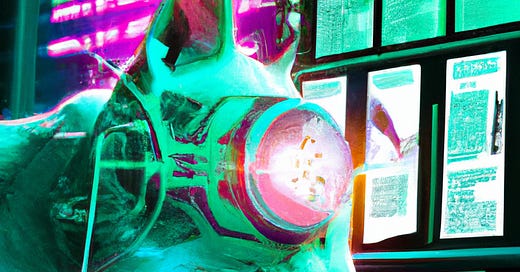ChatDVM: The Future of Generative AI in Veterinary Medicine
3 simple ways these tools can be used in practice today
In recent years, generative AI has made significant strides, thanks to the development of powerful deep learning models and advancements in computing power. These models have shown remarkable abilities to generate realistic images, text, and even music, leading to a surge of interest in the field of AI and its applications.
Two notable examples of generative AI are ChatGPT and DALL-E. ChatGPT is a language model developed by OpenAI that can generate coherent and contextually relevant responses to text inputs, while DALL-E is a generative model that can create novel images from textual descriptions.
While the potential of generative AI is exciting, it has also sparked concerns and debates in society. Some worry about the ethical implications of AI-generated content, including issues of ownership and authenticity. Others fear the potential misuse of these models, such as the creation of deepfakes or other malicious uses.
In this blog post, we will explore the recent history of generative AI, including the development of ChatGPT and DALL-E, and how society has reacted to these advancements. We will discuss the benefits and risks of generative AI and explore how these models are shaping the future of AI and its applications.
If the above paragraphs seem a little duller than my usual writing or conversational style, I agree! There is an easy explanation for this…it was generated by ChatGPT! 100% of the above paragraphs in italics—with no editing—was spit out in about 10 seconds after I entered the prompt below. While the exact wording may lack panache, the content itself is an impressively accurate introduction to a new and complex topic.
Since ChatGPT was introduced last fall, AI—in particular, “generative” AI that is capable of creating novel content from prompts—has become a buzzword and viral sensation. People are using it to write humorous limericks about current events. It was featured on a John Oliver segment with fans generating images of him marrying a cabbage. There have also been more concerning stories of students using ChatGPT as shortcuts for class essays, the tendency for it to “hallucinate” factual errors and make up sources, and worries over deepfakes and misinformation. Companies like Google and Microsoft are rushing to implement their AI chatbots into their search engines (despite some eyebrow raising failures), and there are plans to integrate generative AI functions into consumer software including Microsoft Office.
With generative AI being so new and controversial, why would I want to write about how this could be used in veterinary medicine? I have already written about some of the perils of AI, as has fellow veterinarian Substacker Dr. Tancredi, and I anticipate returning to that subject often. But like it or not, these AI tools are here to stay; companies in all industries will soon be using AI (if they aren’t already). Rather than stubbornly refuse the technology like the Luddites who smashed their mechanized looms in vain, it’s critical to understand the potential benefits alongside the pitfalls of the technology. Without further ado, here are three very basic use cases for generative AI in veterinary medicine that you can start playing around with…
Keep reading with a 7-day free trial
Subscribe to All Science Great & Small to keep reading this post and get 7 days of free access to the full post archives.





